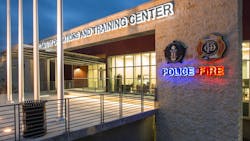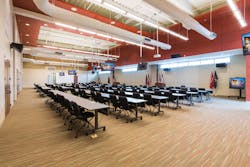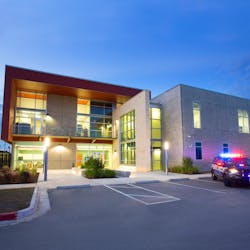When building a new facility, whether it be solely for law enforcement or a joint public safety facility, many factors need to be taken into consideration. From the security of the building to how welcoming it appears to the public, there’s a lot that goes into the planning stage, but what about the functionality of the project as a training opportunity?
Wayne Nero is the retired police chief of Georgetown, Texas, and currently serves as the assistant city manager of the locale that is home to a population of over 80,000. When he took over as chief in 2010, one of his first major tasks was starting the planning process for a new public safety operations and training complex, which is shared with the city’s fire department administration.
“Not only did we need space, but the theme became training,” he says, noting that the city’s population has nearly doubled since he first took the post as chief. “We knew we were going to grow fast, those were all of the projections, and we needed to build competent people.”
Nero spoke during a session at the 2022 Station Design Conference in and was joined by Sami Gerwick with Architects Design Group. Phase I of the project was completed in 2015 and Phase II is set to be completed next year.
The importance of training
Nero stressed that a lot the issues faced by officers can often be tied back to training. He pointed to a culture of speed in law enforcement, assault against officers, poor nutritional habits, a lack of exercise and the need for a focus on mental health. “We lose officers in these four areas every single year and in my three decades of doing this, do those numbers ever change? Let’s be honest,” he says. “We don’t do enough in the realm of training. We do a lot of box-checking in our profession. There’s a lot of things that work against us when we check the box rather than train for competency.”
In the state of Texas, there are 720 hours of training mandated in the academy and 40 more hours of in-service training every two years. “If that’s all you do—40 hours of training every two years–if that’s all you do, how competent are your officers going to be?,” he says.
When Nero arrived in Georgetown, the department completed about 48 hours of training per officer annually. Over the last decade, those numbers increased exponentially. Prior to COVID, officers completed around 190 hours of training each per year. Last year that number was around 175 hours. As chief, he also gave his staff an hour per shift to work out built into their schedule.
Nominations are currently being accepted for the 2022 Officer Law Enforcement Station Design Awards
Nero stressed that the department focuses on full-spectrum training. “It’s everything from how we talk to people, to how we put our hands on people to how we run guns.” He says that when interacting with the community, it is important to be able to tell your agency’s story through training and be able to explain things like accreditation. By meeting with community members that had negative views towards the police department, Nero was able to connect with them and was able to convert them into advocates instead of adversaries.
Working training into the plan
Gerwick says that training is only as important to a plan as the agency and firm makes it. “From the very onset, we have to build these programs into the space needs assessment,” he says. “We have to identify the importance of training. It’s not just a list of spaces that you want to include in your building. It is a set of goals and aspirations that your department is aimed to.”
Law enforcement agencies must communicate the benefits of an onsite training facility to the elected officials who hold the keys to funding. By providing onsite training, officers aren’t forced to travel outside of the county, sometimes hours away, for training, spending money on gas and hotels. Another benefit is the ability to rent out the training facility to other jurisdictions.
“If you have a 20,000-square-foot training program in your space needs, that could be $8 million or $10 million. Elected officials will say, ‘We don’t have that in the budget.’ You’ll have to choose between your day-to-day operations and a training facility,” says Gerwick. “Training is important. We want to keep training in the program. We want to make sure everyone understands the importance of it, and it will be in the building one way or another.”
Law enforcement agencies also have to weigh all of the options when it comes to the location of their training program and choose the one that is right for them. In Georgetown’s case, it chose to include space on site for a separate training facility.
“That facility doesn’t necessarily have to meet the same stringent design criteria necessarily as the police department,” says Gerwick. “That other building could be just a concreate box. It’s not facing the street and doesn’t need to be as pretty.”
Another option is to build the training program into the plan, not build it right away and work it into the next budget cycle. He also stressed spaces must be flexible and different solutions can be added later. This includes driving and training simulators and even live-fire shooting ranges.The end result
The Georgetown Public Safety Operations and Training Complex consists of 106,353 square feet, was designed to withstand estimated F3 tornado forces and was designed to meet future needs through 2030.
The complex includes a 76,831-square-foot main building containing administrative offices for the entire police and fire department administration, community room, training classrooms, communications center, physical agility room, locker room, quiet room, and kitchen. The building also includes a chemical processing lab, crime scene investigations lab, evidence processing lab and two vehicle evidence processing bays.
The 18,672-square-foot tactical training facility includes a flexible training area with reconfigurable walls for reality-based training, a cross fit box, video production room with green screen, storage and office space, outdoor covered classroom and rolling asset storage. The site also includes a 1/3-mile slow speed EVOC track with a skid pad, a 125-foot high communications tower, obstacle course and an on-site central energy plant.
“We use this more than you would imagine,” says Nero about the training facility. “It’s like a burn tower for the firemen. If you have it in your backyard, you’re going to use it all the time. It you don’t have one, you’re going to pay money to use someone else’s for a fraction of the time.”
A 10,850-square-foot hybrid indoor/outdoor live fire range was included in the original master plan as Phase II, and is set to wrap up construction in 2023.
When it comes to pitching a similar plan to city stakeholders, Gerwick says that partnering with other agencies—as Georgetown did—can open some doors “It becomes a public safety training facility and not just a police training facility,” he says. “There are some connotations that change in that perception and can benefit you.”
About the Author
Paul Peluso
Editor
Paul Peluso is the Managing Editor of OFFICER Magazine and has been with the Officer Media Group since 2006. He began as an Associate Editor, writing and editing content for Officer.com. Previously, Paul worked as a reporter for several newspapers in the suburbs of Baltimore, MD.




